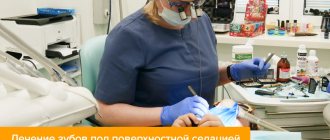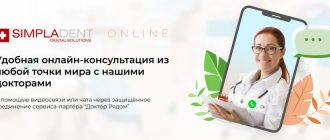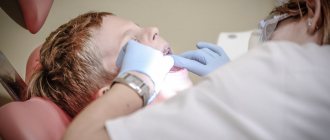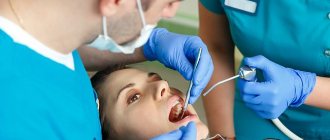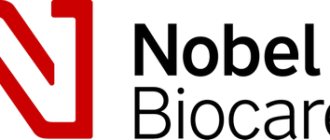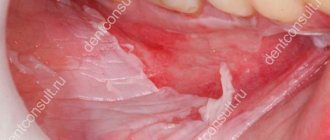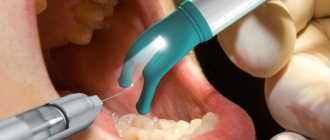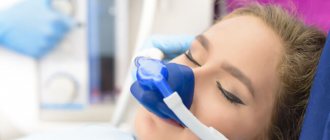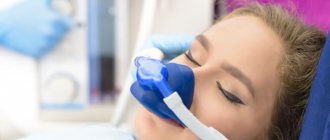Nowadays, with many safe anesthetic drugs available, the use of general anesthesia for dental treatment or extraction may seem excessive. However, it allows you to carry out any procedure - treatment, tooth extraction, restoration of fillings or sanitation of the oral cavity - completely painlessly. Many people still choose to have teeth removed under general anesthesia. Be that as it may, the choice of anesthesia method remains with the patient; the doctor’s duty in this case is to give the patient information about the advantages and consequences of each method.
Pediatric anesthesia in dentistry
First, let's figure out what anesthesia is. This is a reversible inhibition of the activity of the central nervous system, which we cause artificially.
Narcosis is characterized by:
- falling asleep and decreased reflexes;
- loss of consciousness and muscle relaxation;
- complete absence of painful sensations.
Translated into simple language, this means that during general anesthesia the child falls deeply asleep, lies motionless during the procedure and does not feel anything. And after waking up he doesn’t remember anything.
They are immersed in this state using a combination of several drugs, which ensures safety and comfort for the baby. At the same time, safety comes first. Modern methods of general anesthesia completely eliminate the negative impact on the mental and physical development of a small patient.
Unlike adult dentistry, in pediatric dentistry there is no intermediate option between superficial sedation and anesthesia. This means that for children under 16 years of age there are only two options for “sleep treatment”: superficial sedation, when the child remains awake during treatment, and general anesthesia (endotracheal anesthesia). This is due to the anatomical and physiological characteristics of children. Because of them, deep intravenous sedation is impossible.
What is sedation dental treatment?
Sedation is a method of pain relief based on immersing the patient in a relaxed “drowsy” state by inhaling a nitrogen-oxygen mixture or intravenous administration of sedatives. There are two types of such anesthesia: deep sedation, when the patient is in a state of deep sleep and does not respond to external stimuli, and superficial, in which the patient is half asleep, completely retains breathing and is able to hear and follow the doctor’s instructions. In dentistry, dental treatment with superficial sedation is usually used. This method allows you to eliminate discomfort from dental procedures, relieve fear and ensure the absence of stress.
At the same time, the need to carry out conventional local anesthesia remains, since the patient remains able to feel pain. Therefore, the technique involves putting the patient into a state of half-asleep followed by anesthesia - this ensures complete comfort and painlessness of therapeutic procedures.
Should children undergo dental treatment under anesthesia when they cry?
If your baby cries at the dentist, he may just be very emotional. And then, to calm him down, kind words are enough.
An experienced doctor knows how to find a common language with children, and there are usually no difficulties with treatment. There are many adaptive techniques when the doctor explains to the child in a playful manner that treatment is interesting and not painful at all. In addition, to cope with your baby’s fear, you can use the help of a psychologist.
If these methods do not help, then you can try the procedure under sedation. It muffles fear and temporarily dulls the baby's reactions.
Tears are not a good reason to perform dental treatment under anesthesia in children. It is worth resorting to it only if other methods of “agreeing” have not been successful. Anesthesia in pediatric dentistry is used if there are indications for it.
Treatment of baby teeth under anesthesia is carried out:
- if it is impossible to establish contact with the baby;
- dental treatment for children under 3 years of age;
- allergies to local anesthesia;
- mental illnesses or nervous system disorders: schizophrenia, epilepsy, Parkinson's disease, cerebral palsy, mental retardation;
- insurmountable fear of dental treatment (scientifically called dentophobia);
- strong gag reflex, which interferes with the treatment of distant teeth;
- extensive surgical operations: complex tooth extraction, abscesses, periostitis, lymphadenitis, serious jaw injuries.
When children should not use anesthesia for dental treatment:
✔
during the acute course of the infectious process;
✔
with decompensation of severe chronic diseases.
In general, there are no absolute contraindications to general anesthesia in children. Sometimes you just need to wait for the right moment or choose the most suitable technique. If the baby has an acute situation - pain or injury - there is always the opportunity to safely and comfortably undergo treatment under anesthesia.
Types of combined anesthesia
- Neuroleptanelgesia. The method involves a combination of antipsychotic and narcotic drugs. In this case, antipsychotics have an inhibitory effect on the nervous system, and narcotic substances enhance the analgesic effect. The drugs most often used are: etapyrazine, aminazine, droperidol and haloperidol;
- Intubation anesthesia. The substance enters the respiratory system using a laryngeal mask. Due to its complexity, this method is also not used often.
Ataralgesia. The combination of analgesics and tranquilizers gives a calming, relaxing and analgesic effect. The most commonly used tranquilizer components are: Relanium, Elenium, Phenazepam and Grandaxin.
How to prepare a child for dental treatment under anesthesia
- Before treatment, you should consult with an anesthesiologist. This can usually be done over the phone, but in some cases a face-to-face appointment is required.
To correctly administer general anesthesia, the anesthesiologist will need the following information:
- child development history;
- allergic reactions;
- past acute and chronic diseases;
- previous medical interventions and hospitalizations;
- anthropometric data (age, height, weight).
To clarify the child’s health status, you will need to undergo a series of tests. The anesthesiologist determines the full scope of the required examination based on the characteristics of the small patient and the type of upcoming treatment.
- Before anesthesia, diet is very important. The safety of anesthesia depends on its compliance.
The child who will best tolerate anesthesia is the one who:
- did not eat “heavy food” during the 6 hours preceding treatment;
- 4 hours before the procedure I had a snack;
- I drank water 2 hours before.
Dietary recommendations may vary, so the final meal plan will be discussed in consultation with the anesthesiologist.
- To help parents not be nervous, I also recommend asking the anesthesiologist what his qualifications are and what equipment he will use during the procedure. You definitely shouldn’t be embarrassed about such questions. Doctors with experience in pediatric anesthesiology should work with children, since the structure of the child’s body and its functioning have their own characteristics.
Price
The cost of dental services in a dream includes the main treatment and the use of anesthesia or sedation, therefore it depends on the volume and type of work. After consultation and examination, a treatment plan is drawn up with a list of all services and prices. The use of anesthesia is calculated in half an hour. You will find out the exact cost calculation from your attending physician.
Our clinic constantly runs promotions for sleep services. You can pre-calculate how much treatment will cost in your specific case using the OnLine calculator.
How is dental treatment performed for children under anesthesia?
During treatment under general anesthesia, the child does not feel anything. And he doesn’t remember anything after waking up. This is achieved by a combination of drugs. The main one among them is Sevoran.
The combination of drugs and their doses are calculated individually for each child. In this case, the doctor takes into account the age, weight and characteristics of the small patient. The use of combinations of anesthetics makes it possible to minimize their doses and carry out a high-quality and safe procedure.
The child falls asleep after a few breaths through the mask of the anesthesia machine. This happens in the arms of the mother. We perform induction of anesthesia as comfortably as possible for the baby. If a child comes with his favorite toy, we show her by example: inhalation from a mask is not scary.
In cases where parents warn the anesthesiologist that even a mask causes negative emotions in the child, premedication can be used. Then we administer a mild sleeping pill to the baby in the form of nasal drops, after which the child plays or watches cartoons for 30-40 minutes and gradually falls asleep in his mother’s arms. And then we begin induction of anesthesia.
An anesthesiologist and a nurse anesthetist are responsible for administering general anesthesia. Their interaction ensures the safety of the child. The baby is under constant control, precisely calculated doses of drugs are administered at the appropriate time. It takes approximately 30 minutes in addition to the treatment time for the anesthesiologist to induce anesthesia and wake up.
Advantages
Of course, the main advantage of general anesthesia is the complete absence of any patient movements, which lengthen the operation and complicate the doctor’s actions. In addition to this fact, there are a number of other advantages of dental treatment in a completely unconscious position, that is, the following:
- relevant for super-traumatic procedures, the patient does not feel compression, vibrations or other tactile stimuli at all;
- absence of any pain after the procedure, which is due to the long residual presence of the drug in the blood;
- minimizing the risk of postoperative complications, since the doctor is not distracted by the patient’s reaction, which can be quite different if anesthesia or at least sedation is not used;
- decreased saliva production, which is ensured by special medications;
Despite all the advantages of general anesthesia, its use is indicated only in certain cases, in contrast to sedation, which is used at the request of the patient in the dental office, even when the procedure is minimally invasive.
Important! When performing sedation (not anesthesia), the anesthesiologist always ensures maximum psycho-emotional comfort, since he excludes specific micro-irritants from the child’s memory: white coats, smells of the dental operating room, noise effects, medical sounds and visual stimuli;
Under sedation, it is possible to perform any full-scale operation to restore the dentition (bone grafting, ENT surgery, implantation using sinus lift surgery, prosthetics).
What is rehabilitation like after treatment under anesthesia?
After waking up from anesthesia, in the vast majority of cases, children feel well. Most often, the only thing that bothers them is numbness in the areas where the local anesthetic was injected.
As for behavioral changes, there are three types:
- excitement - the baby may be capricious and cry. This is accompanied by increased activity. But it quickly gives way to fatigue;
- fatigue - the child wants to sleep, refuses to eat, sits in the arms of the parents;
- no behavioral changes after waking up.
The first two scenarios are typical for children under the age of 7-10 years, the third - for adolescents and adults.
Hyperactivity and agitation upon awakening are unpleasant for both the child and those around him. To avoid it, we try to implement the second scenario; to do this, we put the baby to sleep and wake him up gently.
The child can eat immediately after waking up, unless the anesthesiologist gives other recommendations.
Very rarely, recovery from anesthesia is accompanied by nausea or a feeling of motion sickness. This lasts no longer than 2-3 hours. This reaction is typical for children who get motion sickness in transport. In this case, you will be able to eat and drink within an hour or after the nausea has passed.
There is no need to worry about the postoperative period - the anesthesiologist will always be in touch.
Appointment and preparation for surgery
After all the above steps are completed, the date for the operation in a dream is set.
It is important to remember that on the day of the appointment there are a number of actions that need to be completed:
- Do not eat or drink anything at all (6-7 hours before the appointed time);
- It is advisable not to smoke (if the habit is strong, 2-3 cigarettes, but no more);
- Do not drink alcohol for 48 hours;
- Take medications (if they were recommended by the anesthesiologist);
- The uniform should be loose, in no way constrictive and easy to unfasten (no elastic bands, complex locks, etc.);
- Appoint an accompanying person who will take you home by car at the end of the operation.
Complications after general anesthesia
Modern medications and technical equipment are at the highest level in anesthesiology, but there is always a risk of any complications, which patients should know, doctors should take into account and warn. Each human body is individual and, under certain conditions, unpredictable, so it is difficult to give a 100% guarantee of the successful completion of any surgical operation that was accompanied by general anesthesia.
In the practice of anesthesiologists, the following types of complications are encountered, which, in most cases, are noted during the recovery of consciousness after using a drug for anesthesia:
- dizziness, nausea, vomiting;
- psychomotor agitation and confusion;
- severe headache;
- trembling throughout the body;
- muscle pain (back, neck, limbs);
- severe allergic reactions;
- injury to the tongue, lips or teeth (usually characteristic of endotracheal anesthesia);
- infection of the lower respiratory tract, which occurs due to incorrect tracheal intubation;
- fluctuations in basic vital signs (blood pressure, pulse, saturation).
There is also a rate of severe brain damage and mortality, which necessitates the presence of resuscitation equipment and appropriate medications. Informed patients must make their own decision about whether to treat their teeth under general anesthesia , since the doctor cannot guarantee absolute well-being. The best prevention of these excesses is considered to be thorough preparation of the patient, exclusion of contraindications and compliance with all doctor’s recommendations. Modern anesthesia in dentistry reduces the rate of complications to a minimum.
Important! None of these types of anesthesia are used in our clinic, only sedation.
Important! Establishing, licensing and maintaining a full-fledged anesthesiology department requires huge monthly costs.
People usually criticize and dissuade from performing sedation only in those clinics where Rospotrebnadzor issued a refusal and failed to obtain accreditation for this type of licensing.
Safety of general anesthesia
A few reasons why we recommend sedation treatment:
highly qualified specialists
— the procedure is performed by an anesthesiology team with many years of experience working with children of different ages
highly effective drug
— Sevoflurane provides reliable anesthesia and has minimal side effects
constant monitoring by an anesthesiologist
— the specialist carefully monitors the dosage of the drug appropriate to the child’s age and individual characteristics
monitoring the child's condition
— during treatment, the doctor monitors pulse, ECG, blood pressure and other vital signs
Everything you need to know about Sevoflurane
This is a safe drug that was synthesized back in the 70s of the last century. However, it began to be used in pediatric dentistry much later: first in Japan, and in the 1990s in the UK, USA and Western Europe. In 2004, the Russian Ministry of Health authorized the use of Sevoflurane in Russia. During the procedure, the child sleeps without feeling pain or fear, and does not hear the sound of the drilling machine. After stopping the supply, the drug is quickly eliminated from the body, leaving no discomfort.
Stages of treatment in sedation and anesthesia
- Arrival at the clinic and adaptation in the playroom. Comfortable communication with the children's doctor in the presence of parents, a pleasant atmosphere, cartoons and funny dental stories. While walking around the clinic, the patient is led to the desired room.
- Smooth descent into sleep. The child is asked to try on a special mask, after which the patient falls asleep and is comfortably placed on a chair. If dental treatment with a mask is planned, children are started to be given Sevoran; if not, they are transferred to intravenous anesthesia Propofol. To monitor your well-being, the anesthesiologist connects the necessary equipment.
- Treatment under Sevoran. A team of doctors carries out the necessary treatment of dental diseases - filling or removing teeth, performing surgical operations, placing crowns. The anesthesiologist monitors the child's condition. Parents wait in the hall or in a separate office.
- Diagnosis and treatment. If it was not possible to assess the condition of the oral cavity earlier, the doctor will do this immediately after the child falls asleep. If the clinical picture is clear, treatment begins immediately. A team of doctors works with each patient to quickly and efficiently carry out all dental procedures and minimize anesthesia time.
- Awakening. Modern drugs guarantee rapid recovery of consciousness. The patient wakes up 15-20 minutes after the anesthesia is turned off - again surrounded by parents and familiar faces.
- Monitoring the condition and going home. The patient is observed by a doctor for about half an hour after waking up. If the baby is feeling normal, he is allowed to go home with his parents, having previously given the adults a memo with recommendations.
Nitrogen sedation in pediatric dentistry is performed as part of a routine appointment after short-term adaptation.
